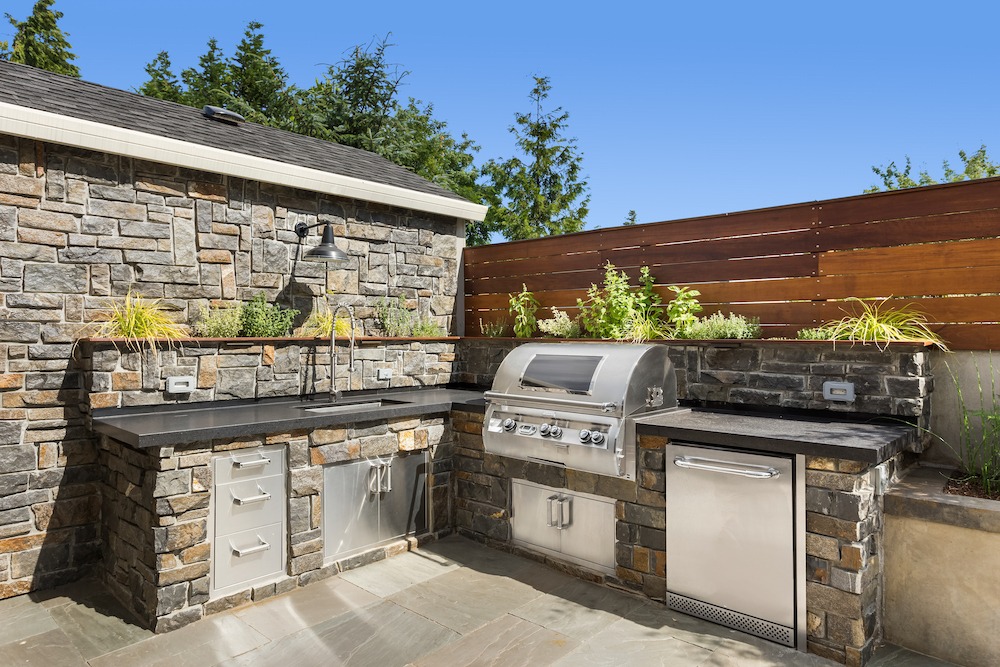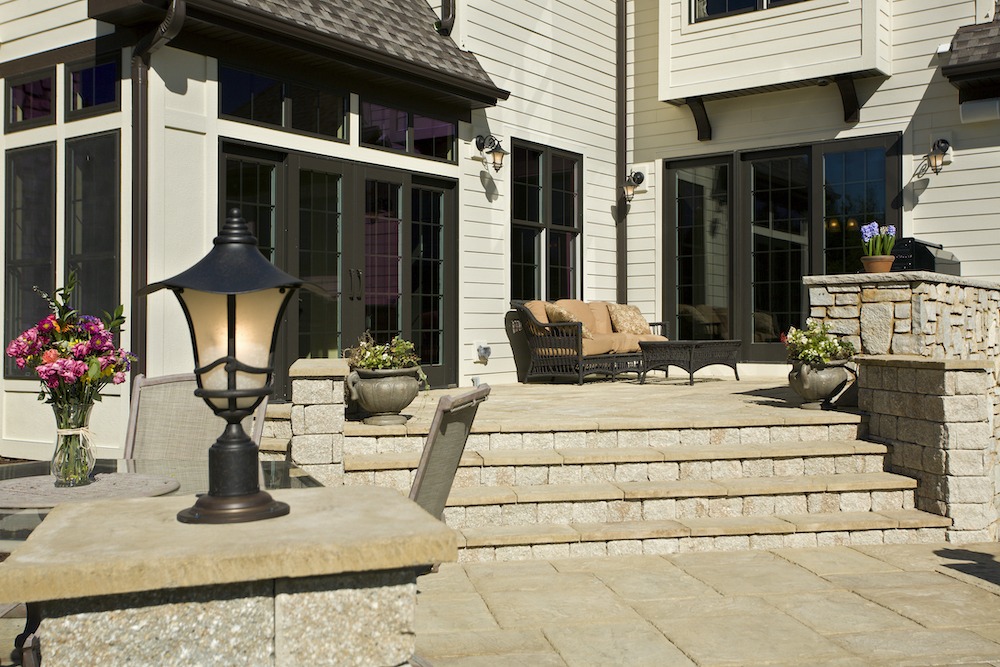Words: Nancy Kristof
Photos: JonHuelskamp, piovesempre, Keystone
Summer is well upon us. This year, the urge to get outside is not just driven by the warm weather, but also because more people are spending time at home due to COVID-19. Being outside can help us stay safer while still being able to enjoy spending time with family and friends.
The concept of the “outdoor living room” is not new, however, it is likely more valued. Many residential, landscape architects and mason contractors have been noting the trend toward investing in outdoor living spaces for some time. The reasons are easy to understand: outdoor areas created with masonry and stonework provide inviting, durable and long-lasting environments. Masonry and stonework are free from the need for excessive maintenance, are sustainable, and offer an abundance of options that can accommodate any design or budget.
The ability to connect to nature just outside our front or back door and without sacrificing comfort is even more appealing as many of us are staying closer to home. We want outdoor living spaces that are useful and provide value to our homes. One type of outdoor space that fits this bill and is here to stay is the outdoor kitchen.
“People are home now, so there is even more interest in creating a livable space because the outside is their safe area,” says Doug Rose, Sales Manager at Pine Hall Brick Company. “Outdoor kitchens continue to be extremely popular. That way you can cook and hang out with your family,” Rose says.
Dave LaCroix, Business Development and General Manager with Keystone agrees. “Outdoor kitchens have been the biggest growth segment in our industry, and we’ve projected it to continue to grow by 5% into 2023,” he says. “However, with everything going on with COVID-19 we’ve exceeded the projected rate and have accelerated that pace,” he adds. “As people are home and not traveling, they’re working on their homes and making them more comfortable,” LaCroix says.

Outdoor kitchens range from the traditional to the trendier, such as permanent outdoor cabinetry, sinks, and pizza ovens. They could include “a good old-fashioned outdoor fireplace to an outdoor brick barbecue, or they can be as fancy as a gas fire unit fireplace for convenience,” says Rose. “We’re seeing a lot of distributors selling pre-made, ready to install pizza ovens,” he adds. Others prefer to have something constructed from scratch to fire their pizzas or cook outside. The flexibility of masonry offers a multitude of options, whether it is an outdoor kitchen, fire pit, patio or all of the above. “People are doing paved surfaces then adding pergolas, overhead lighting, entertainment, and sound systems, further investing in their backyards,” Rose says.
LaCroix and Rose both agree the key to maximizing an investment in outdoor living space is thoughtful planning. Industry trade shows are a great option for ideas and seeing different examples in a physical space, but the internet and home and garden television shows also offer a plethora of ideas while social distancing. The key is to be realistic with the outdoor space your home has to offer. This is where a professional opinion can help make a difference in realistically implementing your vision.
“Know your space, so that the end product looks aesthetically pleasing,” LaCroix says. “Talk to landscape architects and contractors.” Industry professionals do this kind of work for a living, staying on top of trends and best practices. Keystone offers educational programs to teach proper installation for various products so the contractors are comfortable and confident when using them.
“Think about how you intend to use your space, what is important to you, and really think about the layout,” says Rose. “One of the big things contractors face in the hardscape industry is in the beginning stages of planning. Make sure to talk to the client to see what they plan on using in their space,” he says. “Sometimes the client will tell us they only need a 10-foot x 15-foot space for the patio set, then once they put the set-out and chaise lounges where they want them, they realize that now the patio is not big enough to configure the set how they want it,” he says. Also, consider the entire available outdoor area. “You do not always have to put outdoor living space right up against the house. It can be moved out into the yard to create some landscape breaks to soften it, create shade, and make it more usable for different times of the day, and not just at night,” he offers.
The planning phase is also key to keeping your project on budget. There is a multitude of new products and materials that offer flexibility and range in cost.
“Another thing about the outdoor environment is people don’t have to do it all at once,” LaCroix offers. “You can put the paver-patio in this year and do the built-in barbecue next year,” he adds. Budget management is not only an issue for the individual homeowner but is a concern for the industry as a whole as it looks to remain a competitive and viable option for home investments.

“One of the things we’ve done for landscape contractors is to minimize cuts and waste,” LaCroix says. A popular product is Stonegate no-cut designs, which are versatile and result in a contemporary look. “It is a three-piece block system that can be assembled into fire pits, grill stations, and fireplaces,” LaCroix says. “We’ve worked with another vendor to manufacture grills, vents, and propane doors so that they work with the system,” he adds. This makes it easier on the contractor so they can reduce or eliminate cuts. There are also options for two and three pallet designs so there is no waste or leftover materials.
Some of the other material trends include a shift back to natural materials. “Clay, brick, and natural stone products are becoming very popular for paving choices. They are durable and long-lasting, and there is a lot of value there not only because of the price point but because they hold their color for a very long time,” says Rose. He also notes the increased interest in larger-sized pavers.
LaCroix agrees. “We’re seeing large formats now, more than what it used to be. Large format pavers start at 24” x 24” and can go up to 48” x 48”, which is a big paver that requires two people to carry it!” he says. “One of the things we do a lot of is face-mix paver, which is a regular paver with a concrete texture on it that is much smoother with a finer aggregate. Specialty aggregates offer fun and different color and texture options,” he adds.
Regardless of the material choice, the size of space, or the choice between traditional or contemporary design, one other trend that seems here to stay is the integration of technology into outdoor living spaces. Lighting has always been key, says Rose. But now, “there are a lot of companies that have integrative systems where it is the lighting as well as the sound system. This allows people to bring their entertainment outside very easily, and not have to move equipment from inside, set it up, and then have to bring it back in again,” he says.
People look to technology to help customize their space and create an inviting extension of the traditional indoor space to the outside. The possibilities are limitless, including a variety of water features, lighting, and speakers. Weatherproof lighting and sound systems that can permanently stay outside are increasingly popular. “There are a lot of things you can do,” LaCroix says. “Your backyard should be your playground. Smart televisions, wet bars, and in-ground pools are just some of the options available today,” he says.
With a seemingly limitless number of options, it is easy to see why the investment in outdoor living spaces is so popular. Masonry and stone provide the foundation for future customizable space that lasts a lifetime.
